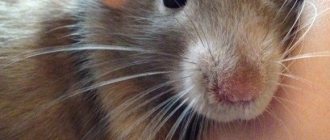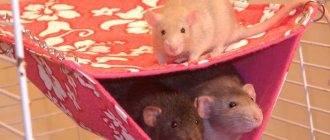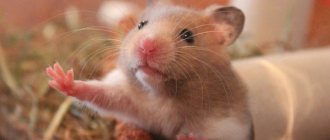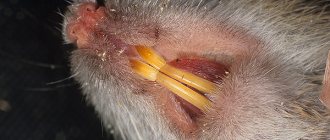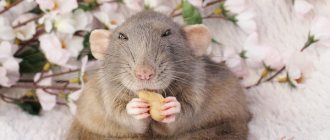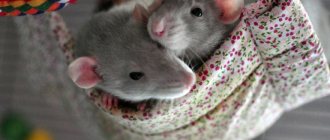- home
- Rat
- Peculiarities
06/21/2019 The popularity of rats as pets continues to increase, but they still have not moved away from their role as pests. These rodents are famous for their cunning and intelligence. They bypass the traps people have prepared for them. As many believe, not only intelligence, but also good eyesight helps rodents overcome traps. Is this really true? The article describes how rats see.
Do rodents see colors?
There are two types of light receptors in the human eye:
- reeds (perceive dim light, make it possible to see in the dark);
- cones (catch bright light, distinguish colors).
The rat eye contains the same receptors, but unlike the human eye, they are located at a great distance from each other. This feature is reflected in the perception of color. The retina of a rat eye receives the following types of spectra:
- medium wave;
- walkie-talkies;
- UV.
Rats can only distinguish between green and blue; they do not recognize shades.
A real homebody
Over the entire history of living next to humans, rats have made dizzying journeys - they populated almost the entire planet on ships and trains. But biologists still say: they are homebodies.
No, sometimes they get the wanderlust itch. For example, in 1966, hundreds of thousands of rats in Thailand, for no apparent reason, walked around the country en masse and swam across rivers. But, as they say, the exception only confirms the rule.
During Soviet times, a scientist tagged black rats living in the Abkhazian forest. Two months of surveillance showed that the rats did not dare move even fifty meters away from the nest.
The gray rats that were spied on in Volgograd were a little bolder - they could break away from their home by 100-120 meters. But with a sufficient amount of food, they staunchly adhere to their habitable place. In general, home sweet home.
Rat.
creativecommons.org
Grooming
They constantly need to comb their white fur, and they also need to be washed constantly. To comb the rodent, use a toothbrush, and be sure to have a soft one. While combing, you will have to hold the rodent with your thumbs and forefingers.
If you find yellowness in your pet's fur, then this is a reason to worry. It is possible that your rat is sick and is unable to care for itself. Important! You should not risk the animal's psyche if you decide to clean the fur by washing it in a basin. You can simply wet cotton pads and wipe your pet's fur. After the procedure, you need to wipe the rodent dry.
Place the cage with the animal away from direct sunlight, as white rats are afraid of bright sunlight.
Ways to see a pig in the dark
Like other rodents, guinea pigs have good orientation and vision in dark rooms. Despite the virtual absence of helplessness at night and the ability to perform basic operations, vision in rodents is still considered daytime. Because of this, it is ideal to place the cage in a well-lit area, but away from direct sunlight. Experiments have been conducted to prove the negative influence of darkness on the animal. Degradation, disease, and mutations of various types occur. It has been noted that in the process of survival, animals are better oriented in space thanks to hearing and smell rather than vision.
A rat's sense of smell is a billion times greater than the human sense of smell.
Interestingly, the rat's tail, which everyone considers ugly and disgusting, is the most valuable both in itself and in scientific research. Most often, drugs are injected into the tail vein. The tail retains all the body heat: the rat hugs the tail and warms itself - this is its heating pad.
The rat also has superpowers. While the human ear can hear sounds with a frequency of 30 decibels, a rat can perceive sounds with a frequency of 0 decibels: this means that it can hear our breathing. A rat's sense of smell is a billion times better than ours. On the other hand, rats have poor eyesight, especially lab rats.
Is the rat a threat in scientific research?
A rat can carry 14 parasitic and 26 infectious diseases. However, they do not affect the rat itself, but only the vector. However, all animals we buy go through a period of inspection and quarantine, during which the rat receives all the necessary drugs against hidden pathogenic microorganisms and becomes relatively harmless to us.
Of course, working in a vivarium is a dangerous occupation, but from occupational diseases it can only be a cumulative allergy to wool. You just have to take precautions and everything will be fine.
Are a lab rat and a pet shop rat different animals?
— A laboratory rat and a decorative rat are the same type of animal. But decorative rats may have spots. They are bred and fed differently. A rat in a cage should be busy, it should constantly play. Our rats are quiet, they sleep constantly.
Can a rat attack a person?
- If he is hungry or feels threatened, he can easily nip at the ears of a sleeping person. The rat secretes an anesthetic in its saliva so that the sleeping person does not feel anything.
Why are there so many rats in the city?
— Probably because we have a lot of food for them: cafes, restaurants, the private sector, where many people raise cattle. But this is already a question for the Sanitary Inspectorate. They must fight rats and carry out forced deratization. Unfortunately, our people have to fight rodents on their own, and they do not always do it competently and do not always use the right drugs. The Chinese smuggled insecticide “Executioner” has already killed 26 people in the city.
How to feed baby rats
During the first 14-16 days, rat cubs feed only on mother's milk. Then they begin to become more active, crawling around the nest and even trying the food that their mother brings. 3 weeks after birth, the pups eat vegetables, grain mixtures, lean meat, eggs, cottage cheese, and fresh herbs.
There are often situations when small rats are left without maternal care. This happens for various reasons:
- Mom doesn't have enough milk;
- the female died after giving birth;
- someone touched the little rat with their hands, and the mother abandoned him.
In each case, the babies will have to be artificially fed, otherwise they will die.
Orphaned cubs must be kept warm. A lot of paper napkins are placed in the nest. They are replaced as they become dirty. To warm little rats, you can use a rubber heating pad or a plastic bottle with warm water.
To feed the litter, a cat or dog milk substitute, which is sold at a veterinary pharmacy, is suitable. If you can't find it, you can use baby formula. To increase the nutritional value, add a little condensed milk with a fat content of about 12% or glucose, as well as a little calcium gluconate.
It is convenient to feed small rats from an insulin syringe without a needle.
The animal is carefully taken vertically in the left hand, and the head is held with the thumb and forefinger. The tip of the syringe is inserted into the mouth
The piston is moved very slowly so that the little rat does not choke.
In the first week of life, rat pups are fed every 1.5 hours, then every 2.5-3 hours. At this age, they eat no more than 0.3 ml of formula at a time. It is quite simple to determine that the baby is full - his stomach is clearly visible through the thin skin on his stomach. It looks like a white transverse stripe. If its length is two-thirds the width of the body, then the stomach is full. Week-old rat pups eat about 0.5 ml of milk at a time, and at the age of 10-12 days - 1 ml.
Visual orientation
The rodent moves well around the territory under study - it is responsible for this visual memory, in which the position of surrounding objects is recorded. Thus, if you change the location of objects around the rodent, it will lose its orientation in space.
Finally, there are a few other interesting features worth noting. Animals see well at a distance of up to one and a half meters. They see obstacles in their path only from a distance of up to 75 cm. The older the animal, the worse it sees - only animals under two years old have good vision by rat standards.
Relationships with people
Albinos are quite smart and cunning animals, but they are quite trainable. White rats almost always remember their nicknames, and they can also remember the nicknames of their other relatives who live in the neighborhood.
Remember! You should buy a cage with a more secure lock, as these rodents can learn to open cages with simple latches. A simple latch on the door is not an obstacle for an albino rat
We can assume that they are very friendly animals towards people, the same cannot be said about their wild relatives. White rats are quite sociable rodents. They love affection and love to have their backs stroked. Therefore, when you decide to pet your pet, he will not mind.
Important! With regular communication with your pet, you can quickly tame it. But we must remember that these rodents have excellent memory and remember well those who hurt them.
What to feed
Black and white rats are practically omnivores, so you won’t have any trouble feeding your pet correctly, but you still need to remember the basic rules. A rat eats about 40 grams of food per day. Decorative animals need to be fed in the morning and evening.
It is forbidden:
- Pickled
- Salty
- Sweet
- Spicy
- Carbonated
Can:
- Balanced dry food
- Porridges and cereals
Rules:
- Try not to overdo the meat and don't feed it raw.
- Pasyuk loves to sharpen his teeth, so you can add chicken bones to his diet.
- Don't feed too fatty foods.
- Add special vitamin complexes to the albino diet, which is especially important in winter.
If you want to pamper your albino, buy him some nuts, but avoid foods like raw potatoes, rhubarb, cabbage, green bananas, blue cheese and beans.
Sources
- https://apest.ru/krysy/vse-o-krysah/kak-vidyat-krysy/
- https://petse.ru/gryizun/myish_krys/belaya-krysa.html
- https://www.vetpost.ru/veterinarnye-stati/myshinye/dekorativnye-krysy/obychnye-krysy.php
Varieties
Thanks to the great imagination of genetic engineers and breeders, there is a wide variety of colors of white and black rodents.
The uniform color of a standard ornamental animal is usually black with white spots behind the ears or gray. You can also find brown, chocolate shades with admixtures of white.
As for eye color, there are many variations here too. There are strange individuals with one red and one yellow eye, for example. But more often their color is the same.
Red eyes in albino rats are caused by a lack of protein color, and the color of the coat is associated with the lack of melanin in the animal's body, which is responsible for pigmentation. Although not all white individuals will necessarily have a red color, which is so unpleasant for many. The white rat with black eyes is also often found in pet stores.
Black rodents look very advantageous due to their silky coat and yellow eyes.
Dossier
Rat.
CC0
Full name: Norway rat (gray), black rat, Bosavi and others.
Nicknames. Pasyuk, kurako, shchur.
Signs. Unevenly gray (“agouti”), sometimes with reddish spots, black, white, mottled.
Special signs. Hairless tail, poor eyesight.
Place of residence: planet Earth.
Character: persistent.
Intelligence: above average.
Suspected: in the death of dinosaurs.
Accused of : causing death by negligence of 25 million people in the 14th century alone; theft of someone else's property by an organized group on an especially large scale; destruction or damage to someone else's property, resulting in particularly grave consequences.
Features of cat vision
The cat's organ of vision differs sharply from the human one in structure and ability to perceive space. They have large, round eyes with a convex lens. The viewing angle of space is 270 degrees.
A special feature of cats is stereoscopic vision. Each eye receives its own image of an object, which is then combined by the brain into one three-dimensional picture. As a result, the predator receives accurate information about the location of the prey and the distance to it.
Everything that the left eye sees goes to the right side of the brain and, conversely, the right eye transmits the picture to the left half
The genetic memory of a predator makes animals react to moving objects. Stationary animals are practically of no interest to them. Watching a moving object, the animal begins to actively move its head up and down: this is how the cat changes its viewing angle and focuses on the prey. This natural ability helps the predator calculate the distance to the prey down to the millimeter, which is why the cat’s jump is so accurate.
The special sensitivity of a cat's eyes is directly related to the structure of the pupil. It is located vertically and has increased elasticity. In bright light, it narrows, limiting rays from reaching the retina. Lack of lighting causes the pupil to dilate greatly, allowing more light to enter.
How they see in the dark
The idea that cats navigate in pitch darkness is a myth. The animal sees in minimal light. A cat only needs 10% of the lighting that a human needs. People cannot see anything in such illumination. But this animal is a predator, so its eyes are equipped with additional receptors that have increased sensitivity to light. The tapetum on the back wall of the retina, like a mirror, reflects light twice, which is why cats' eyes glow so much in the dark. In fact, the eyes do not glow, but reflect the rays that hit them.
Cats look at us with multi-colored eyes. Colors like yellow amber, blue sea, blue sky, green grass or bright gold
Good orientation in the space of a dark room is explained by the fact that vision is not the only organ with which cats perceive the world. The secret of the animal is in the especially sensitive organs of touch - vibrissae.
Features of white rats
White rodents have many different features from simple gray rats. Albino rats usually live about 1.5 years. The reason for this age-related mortality is health problems due to weak immunity. For comparison, the dark relatives of white rats live up to 3 years.
They are practically unable to adapt and survive in the wild, so it is not worth releasing them into the wild - this will lead to the inevitable death of the animals
Sometimes there are individuals with dark eyes and grayish-white shades of fur. These rodents have a stronger immune system than their albino relatives. They are called semi-albinos. Semi-albinos, due to their strong immunity, adapt much better to their environment and get sick less often. If they are crossed with an albino or an ordinary gray rat, then in any case the offspring will appear with dark fur.
The albino rat in the photo is too noticeable on the grass: the lack of camouflage does not give rats a chance to survive in nature
White albino rats are light in weight; they are used to living in captivity and therefore do not need freedom. This is precisely why they are very popular in laboratories. Albinos are also quite fertile. A female can breed 14 rat pups per litter. Also, studies have shown that albino white rats have a very high level of intelligence compared to their wild relatives. In addition, white rats have the ability to sympathize and empathize when their relatives are in danger. There are also known cases when albino rats could give all their food to other weaker relatives.
Rat King - truth or myth?
The Rat King is recognized as a rare phenomenon. The tails of several rodents become so tightly tangled that the rats cannot free themselves and untangle them.
Such rats quickly die because they cannot coordinate their actions to obtain food or simply direct movement. Such cases are very rare: throughout the world, over a long period of time, there are only a few dozen such remains. Often these discoveries were made by accident by ordinary people - on their farms, basements or near mills, but despite this, a huge number of myths about such monsters arose, especially in ancient times.
The most interesting thing in these stories is that no one has ever seen such kings live; only rat remains testified to this. To date, there is not a single photo, much less a video, to prove this phenomenon.
Of course, it is difficult to imagine that the tails were intertwined after death, i.e. It is logical that the knot arose during life - the constant bustle of rats could lead to this. A rat can live without food for a maximum of 4 days, i.e. Confused and unable to come to an agreement, such animals are doomed to death.
There is a version about the “fusion” of tails due to cramped circumstances: in a cramped and narrow space, sooner or later the tails will become connected. Or, according to another version, the tails may become tangled due to contamination, food debris, blood or sticky substances sticking the rats' tails together. Another theory is that the tails freeze together when rats try to stay warm in cold weather. In any case, after waking up, the rats try to run away in different directions, only tightening the knot more.
Structure of a rat's eye
The visual organs of these rodents can be black, ruby or pink. But this does not mean that their structure is different. The eyes of rats are no different from the eyes of other mammals. Even newborn rats, which open their eyes after 2-2.5 weeks, have exactly the same structure as adults.
Due to the location of the visual organs, these animals have poorly developed binocular vision. It allows people and animals to perceive depth.
Did you know that these furry animals can dream and even be tickled like humans?
Characterized by intelligence
Yet the secret to the success of this species lies largely in its intelligence. It’s not for nothing that the Polish zoologist Miroslav Gushch called him an intellectual of the animal world.
Here's the plot: a rat trap with poisoned bait. Do you think this is the end of the rodent? No matter how it is. Rats are suspicious of new foods. And if their poor comrades fall for the poison, the rest will quickly realize what’s going on and won’t touch the bait.
Some scientists are even sure: rats deliberately send their friends, who are on the lower steps of the hierarchy, to taste the bait. And if they went to their forefathers, the old experienced animals will stain the poisonous food with droppings.
Moreover, observers note that they are even able to shake the dangerous bait out of the rat trap and bury it in the ground - so that careless youth are not in danger.
Rat.
visualhunt.com
Perception and orientation
Panoramic vision helps rodents perceive the environment and navigate it. With its help, they cover a large area, which helps to avoid dangers. On the one hand, this can be considered a plus, and on the other, a minus, since this location of the eyes interferes with the perception of depth.
Since rats have very poorly developed binocular vision, they cannot accurately understand how far away an object is. To move safely, they learned to use their nose and receptors located near their whiskers, the so-called vibrissae.
What are the visual fields of animals?
Field of view is the space perceived by the eye with a fixed gaze. There are two main types of vision:
- binocular vision - perception of surrounding objects with both eyes
- monocular vision - perception of surrounding objects with one eye
Binocular vision is not present in all species of animals and depends on the structure and relative position of the eyes on the head. Binocular vision allows you to make fine coordinated movements of the forelimbs, jumping, and move easily.
For predators, binocular perception of hunting objects helps them correctly assess the distance to the intended victim and choose the optimal attack trajectory. In dogs, wolves, coyotes, foxes, jackals, the binocular field angle is 60-75°, in bears it is 80-85°. In cats, 140° (the visual axes of both eyes are almost parallel).
Monocular vision with a large field allows potential victims (marmots, gophers, hares, ungulates, etc.) to notice the danger in time. reaches 360° in rodents, 300-350° in ungulates, and more than 300° in birds. Chameleons and seahorses can look in two directions at once, because... their eyes move independently of each other.
Attitude towards a person
The decorative albino rat is a tame and loving animal. He is trainable, cunning and intelligent. Many owners claim that the rat quickly learns to open the lock on the cage. She thinks quickly, and is significantly different from her dark brothers. Watching your pet play is a pleasure. The Internet is full of videos where albinos willingly perform various tricks, climb around the room, and simply live.
A kind and gentle rat loves its owner. I’m ready to spend whole days on my hands, knees, or in my pocket. Having settled comfortably on a person, she shows her affection with all her appearance. She climbs into her arms to be stroked on her back.
Regular communication with your pet can be turned into training. The rat quickly remembers its name and the names of its cage neighbors. It is better to train animals to communicate with other pets gradually and carefully.
Attention! Albino rodents have excellent memory. They easily remember the person who hurt them. In response, guests or unfamiliar people will receive bites and aggression.
Night rumble
Don't expect your rat to follow the same schedule and rhythm of life as you. On the contrary, be prepared for the fact that the rat is active at night and sleeps during the day. The period after dinner is a great time to socialize and play with your pet. The attempt can be resumed early in the morning - whatever is more convenient for you. You may also enjoy the funny positions in which rats like to sleep - lounging on their backs, curled up into a tight ball, etc.
Scavenger Hunters
Rats have a habit of picking up and dragging to a secluded place something that might be suitable for playing or chewing. Rats steal and drag objects made of wood, plastic and rubber into their lair. They are happy to carry objects made of paper or fabric. Rats are also great masters at arranging all kinds of stashes and food supplies.
Fighting boxers
Not only kangaroos have shown themselves to be boxing fans! Rats also love to box - they stand on their hind legs and heartily begin to kick each other with their front legs. But this is not for fun: two rats find out which of them is the alpha male, the dominant male. Rats have a very developed social hierarchy. Sometimes you can see how, instead of a desperate fight, rats stand up frozen nose to nose. They may not get up - rodents have many different variations on this theme.
Rat bites
If a rat bites or licks you, perhaps this is how it demonstrates its love. Rats also have a wonderful sense of smell, and may well bite you if you carelessly took something edible before entering the cage. Before working with a rat (and also after), wash your hands thoroughly with soap and water.
Teeth grinding
This phenomenon usually accompanies the bulging of the eyes described above. There is no need to be scared, the rat belongs to the rodent family, and its teeth are constantly growing. When a rat grinds its teeth, it tries, so to speak, to moderate their growth, to make sure that they do not grow too quickly. Moreover, teeth grinding in rats is similar to purring in cats - this is what they do in moments of relaxation and peace. This creates vibrations that help the eyeball protrude - therefore, these two phenomena are interrelated. At the same time, a rat may grind its teeth when it is scared or in pain, so pay attention to the circumstances under which this happens (for example, when you pet it or vacuum near the cage).
Gnaws everything in sight
And the trouble is not only in our heroine’s good appetite. The rat needs to grind its teeth all the time - after all, its incisors are constantly growing at a speed of up to 2-3 mm per week. And God forbid if they get their teeth into something super important!
Once in Japan, a rat stopped 16 trains on the Tokyo-Osaka line. The investigation into the case showed that the scoundrel chewed through the alarm cable and turned off the traffic lights.
In the house of an altapress.ru friend, a rat named Krysya chewed the phone buttons, the Mac keyboard and got to the computer mouse. The battle between the rat and the mouse ended with the acquisition of new and expensive peripheral devices, and the hooligan was briefly placed in an isolation ward - a cage.
Isolating it is the only way out, because it is hardly possible to hide anything from this creature. She easily jumps to a height of up to a meter, makes her way between vertical surfaces to the target, and moves through pipes. And at the same time, he easily remembers the most winding path, feeling comfortable in city communications.
Rat.
visualhunt.com
